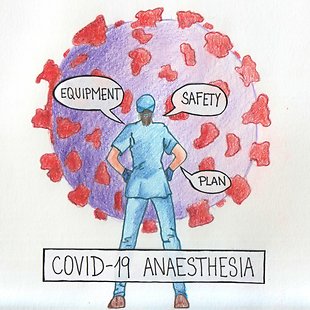Anaesthesia of COVID-19 positive patient
Number of patients infected with COVID-19 worldwide is still growing. The risk of transfer of infection to the medical personnel is high, especially when aerosol generating procedures are done, for example intubation. Anaesthesia of COVID-19 positive patients has it's specifics, which must be taken into account, due to safety of the patient and due to safety of the medical personnel as well. Algorithm will guide you through the basic steps of preparing anaesthesia team and workplace, correct use of personal protective equipment and uncomplicated airway management of COVID-19 positive patient undergoing surgery in general anaesthesia.
Review
In the context of COVID-19 infection, the problematics of safety of anaesthesia personnel during particular phases of general anaesthesia at the operating room became again very important. Standard practice, particularly anaesthesia induction and awakening, are inadequate and risky in case of COVID-19 positive patient. Each anaesthesia workplace was forced to come with new guidelines and measures almost overnight. Analogically reacted expert societies not only in our country. Thanks to the simplicity of sharing information, each anaesthesiologist received huge amount of information in the last months, about how to deal with COVID-19 positive patient in different situations. However, not always these information resulted in clear recommendations applicable in local conditions.
Algorithm prepared by AKUTNE.CZ team submits to the reader easily and clearly simple approach for anaesthesia maintenance at COVID-19 positive patient. It is based mainly on valid guidelines of our expert societies. Its aim is not to demonstrate correct approach in all possible situations that might happen during general anaesthesia. This should be based on the possibilities of each workplace, anaesthesiologist's experience and application of the recommendations mentioned above.
May this algorithm be an inspiration for leading workers of anaesthesia workplaces while preparing their own guidelines for safe practice for anaesthesiologists, and illustration of anaesthesia practice in difficult conditions for other medical personnel.
Sources
Bezpečné používání osobních ochranných prostředků (OOP) při poskytování lůžkové zdravotní péče pacientům s COVID-19. In: csim.cz [online] 2020. [cit. 04-05-2020]. Available at: https://csim.cz/covid-19/dokumenty/
Anaesthesia and caring for patients during the COVID-19 outbreak. In: asa.org [online] 2020. [cit. 04-05-2020]. Available at: https://www.asa.org.au/wordpress/wp-content/uploads/News/eNews/covid-19/ASA_airway_management.pdf
Jonathan Chun-Hei Cheung, Lap Tin Ho, Justin Vincent Cheng, Esther Yin Kwan Cham, Koon Ngai Lam; Staff safety during emergency airway management for COVID-19 in Hong Kong. In: thelancet.com [online] 2020. [cit. 04-05-2020]. Available at: https://www.thelancet.com/journals/lanres/article/PIIS2213-2600(20)30084-9/fulltext
COVID-19 Airway managament. In: asa.org.au [online] 2020. [cit. 04-05-2020]. Available at: https://asa.org.au/wordpress/wp-content/uploads/SAS-Covid-19-Infographics.pdf
Mengqiang Luo, Shumei Cao, Liqun Wei, Rundong Tang, Shu Hong, Renyu Liu, Yingwei Wang; Precautions for Intubating Patients with COVID-19. In: Anesthesiology [2020]. [cit. 04-05-2020]. Available at: https://anesthesiology.pubs.asahq.org/article.aspx?articleid=2763451





